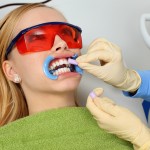
Dental bleaching has become a popular intervention for facial attractiveness. The two most widespread approaches are at-home bleaching using trays or in-office bleaching employing higher concentrate bleaching agents. Bleaching sensitivity has been reported by 50-80% of patients with bleaching sensitivity being reported in 51% for at home protocols and 61% for in-office protocols.
The aim of this review was to assess whether in-office bleaching with low/medium hydrogen peroxide concentrations produced similar colour change and bleaching sensitivity to high hydrogen peroxide concentrations.
Methods
Searches were conducted in the Medline, Cochrane Library, LILACS, Scopus, Web of Science, SIGLE, ProQuest Dissertations and theses, Periódicos Capes Theses database, Current Controlled Trials, International Clinical trials registry platform, ClinicalTrials.gov, Rebec, and EU Clinical Trials Register databases with no date or language restrictions. Parallel and split-mouth randomized controlled trials (RCTs) comparing low/medium and high concentrate hydrogen peroxide (HP) for in-office bleaching of permanent teeth were considered. HP concentrations greater than 30% were classified as high, concentrations from 20-30% medium and those below 20% as low. Data on colour change at time periods ranging from 7 to 30 days and bleaching sensitivity (BS) were extracted. Three reviewers independently assessed risk of bias using the Cochrane domains-based tool (RoB1) and meta-analysis performed where possible. Certainty of evidence was assessed using the Grading of Recommendations: Assessment, Development, and Evaluation (GRADE) approach.
Results
- 25 RCTs (16 parallel, 8 split-mouth) involving a total of 1126 patients reported in 28 papers were included.
- Patients ranged from 11-75 years of age with a mean age of 24 years.
- 19 studies used an objective method of colour assessment (spectrophotometer or chromameter)
- 20 studies evaluated the intensity of BS and 12 the risk of having BS.
- 8 studies evaluated patient satisfaction.
- 5 Studies were considered to be at low risk of bias, 13 at unclear risk and 5 at 7 at high risk.
Colour change
- Overall meta-analysis (19 studies; 12 low v high,7 medium v high) did not show a statistically significant difference between the groups, MD = -0.52 (95%CI; -1.37 to 0.33).
- However, a difference was seen between low and high concentrations, MD = -1.16 (95%CI; -2.10 to -0.21) low certainty of evidence.
Bleaching sensitivity (BS)
- 12 studies (6 medium v high, 6 low v high) were included in the analysis of risk of BS. On average, the risk of having BS was 33 % lower for the less concentrated HP products, RR = 0.67 (95%CI; 0.51 to 0.86).
- 19 studies (10 low v high, 9 medium v high) were included in the analysis of intensity of BS.
- Significant difference between groups were observed, overall SMD = -0.47 (95%CI; -0.66 to -0.28) favouring the low and medium concentrate HP groups.
Conclusions
The authors concluded: –
Low and medium hydrogen peroxide concentrate products for in-office bleaching have lower risk and intensity of bleaching sensitivity than the high concentrate hydrogen peroxide group, with no difference in colour change efficacy.
Comments
The authors have undertaken an extensive database search identifying 25 RCTs mainly small studies with on average 45 patients per study (range 6-136). Three concentration ranges were considered, high with ranges of 35%–40, medium (range 20–30%) and low (range 6%–15%). While colour changes were evaluated using shade guides in 23 studies a significant proportion of the included studies used a spectrophotometer or chromameter. The findings indicate no differences in colour changes between the low/medium and high bleaching concentrations which may be related to the sensitivity of instrument measurement. The evidence supporting potential differences in tooth colour was assessed to be of low certainty using the GRADE approach. The risk of bleaching sensitivity for 33% lower for the lower concentration agents. The intensity of bleaching sensitivity was also significantly lower with the lower concentration agents. The evidence supporting these two findings was considered to be of moderate certainty.
Links
Primary Paper
Maran BM, Matos TP, de Castro ADS, Vochikovski L, Amadori AL, Loguercio AD, Reis A, Berger SB. In-office bleaching with low/medium vs. high concentrate hydrogen peroxide: A systematic review and meta-analysis. J Dent. 2020 Oct 15;103:103499. doi: 10.1016/j.jdent.2020.103499. Epub ahead of print. PMID: 33068711.
Other references
Dental Elf – Dental Bleaching Posts
